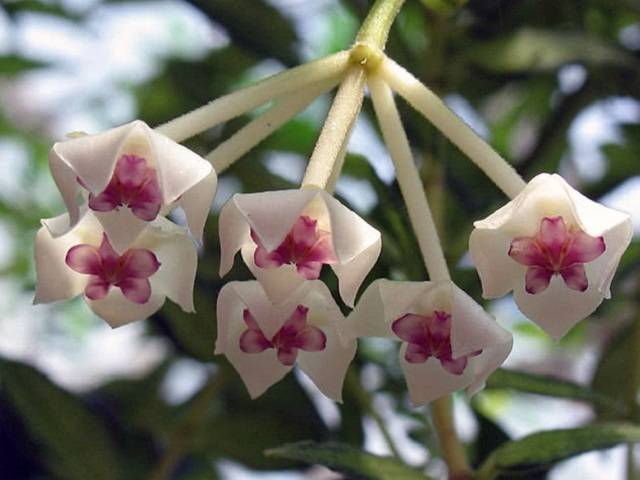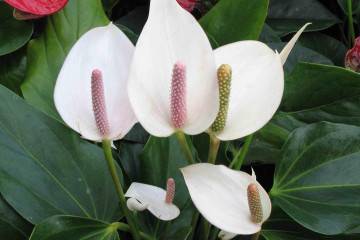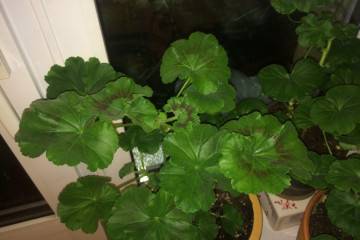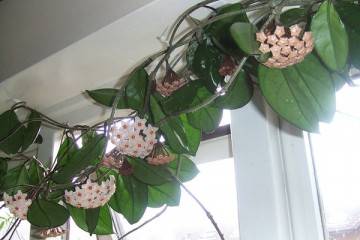Why hoya does not bloom at home
Content:
Hoya is a climbing plant native to the Far East and the rainforests of Australia. It is characterized by leathery leaves, from which beautiful numerous inflorescences grow from May to September. The flowers emit fragrant white or pink nectar.
Many novice flower growers ask why hoya does not bloom at home, what to do in this case? Indeed, sometimes the plant does not bloom for several years. It is necessary to find out how the cultivation and flowering takes place, the features of watering and other tricks that will help you get a beautiful and abundantly flowering plant.
When and how often does it happen?
Hoya is a light-loving plant. When grown indoors, it blooms profusely only on the south side. Shade the plant from direct sunlight.
Dislikes drafts, temperature changes and severe hypothermia. May die at temperatures below +10 degrees. Many are interested in the question of how to care for a hoya and how to make it bloom.
In summer, the plant needs to be watered 1-2 times a week, in winter 2 times a month. Spraying the leaves and removing dust will have a beneficial effect on its growth. You can transplant a young shoot once a year; older plants do not like this procedure.
What the process looks like
Flowering begins with the appearance of small buds.
They then unfold into beautiful wax stars of delicately scented flowers that adorn long, curly shoots with fleshy green leaves.
Ornamental hoi are bred for long flowering times. Young shoots stand out against the background of brown-purple green leaves. The flowers are collected in dense umbrellas and have a good scent.
Leaving during flowering
The hoya plant, the flowering of which cannot be compared with any other flower, requires special care.
The place where the plant is grown should be light, but not sunny (H. bella prefers light partial shade). He loves warmth, but in winter he needs a more moderate temperature of about 12-14 degrees. H. carnos grows well at room temperature all year round.
Khoja does not like transplants, because it has a bad effect on the formation of flower buds. Therefore, the transplant is extremely rare, every few years. Good drainage is essential.
What to do to see the blossoming flowers?
Often questions are asked about why hoya does not grow? To get a flowering plant, you need to carefully follow the conditions for its cultivation. There are rules of care and ways to make hoya bloom at home.
When choosing a plant for a room, you need to take into account its size. Some plants grow quite large, like real trees. Other types are compact and do not take up much space.
You can hang the flowerpot high or wrap the stems around the support.
Flowerpot size
Depends on the age and variety of the plant:
- ordinary pots are suitable for decorative flowers;
- hanging pots are used for climbing plants;
- large varieties should be planted in large flowerpots. Lighting.
The plant comes from rainforest, so it grows best in areas with bright, diffused light. The pot should be placed as close to the window as possible.
Proper watering
Khoja does not like intensive watering, prefers light drying. Watering should be done in moderation. Excess water is very harmful. Fertilizers are given during the growth and flowering period once every 2 weeks, with a gradual dose reduction.
Wintering
Hoya usually rests in winter, so you need to reduce irrigation and fertilization. Most often, the plant blooms in the spring and summer and requires regular watering, spraying and fertilization.
Substrate
Some types of plants require high soil acidity. There are varieties that cannot grow normally if the room is less than +20 degrees.
Top dressing
For regular flowering, regular correct feeding is imperative.
Age
Young plants begin to bloom within 5-6 months after proper planting. The old ones bloom annually.
"Bathhouse"
To stimulate the ejection of peduncles, the heating method is often used. To do this, the flowerpot is placed in a bucket of warm water (+40 degrees) and left to warm up for 1-2 hours.
Possible problems
The hoya flower, when it begins to bloom, can hurt and wither if not properly cared for. Below are the main mistakes that are often found among amateur flower growers.
Lack of transfers
The flower does not like moisture, with poor drainage in the pot and strong watering, the roots can rot. If not transplanted into another container and fresh soil on time, the plant will die.
Lack of fertilizer
With insufficient fertilization, the flower will look lethargic, dull and will not be able to bloom. The planting medium should be loose. You need to prepare a mixture of peat, perlite, coconut and bark. To obtain nutritional value, you need to add a little humus from the leaves. Most species prefer neutral or slightly acidic soil. However, there are varieties that require a higher calcium content.
After a year of growth, the plant will lack the essential nutrients potassium, nitrogen and phosphorus. This can result in slower growth and a change in the appearance of the leaves.
In the absence of nitrogen, the foliage turns light green or yellow and then falls off.
Lack of phosphorus is expressed in reddening of the leaves or tops.
In the spring and summer, Hoya is watered every two weeks with a complex fertilizer for flowering pot plants.
Incorrect containment conditions
There are several conditions under which a flower will not bloom:
- cool indoor air;
- bright sun;
- low humidity or excessive watering;
- too dry air;
- poor drainage;
- cold irrigation water;
- lack of nitrogen.
If the flowerpot is installed in a through place and the cold outside air reaches it, the plant may die. Over-watering will also damage the root system and it will start to rot from excess moisture.
Large pot size
Hoya doesn't like big pots. In small ones, on the contrary, it grows quickly. Therefore, when choosing a pot, it is preferable to use small flowerpots.
Too large a flowerpot for a compact indoor variety will interfere with the development of the flowering process.A lot of moisture will accumulate at the bottom of a large container, which this flower does not like. Even good drainage will not be able to prevent root rot and death of the bulb.
The bulb is too deep
If planted too deep, it will be difficult for the shoots to develop properly. The bulb head will start to get wet and rot, leading to disease.
Lack of a dormant period
Ivy can bloom in winter. If the florist wants to make such a spectacle, then planting should begin in September. Place the pot in a bright, cool place and reduce watering. It is best to place the flower on the eastern windowsill. In December and January, the flower is practically not watered. Drought stimulates well the formation of peduncles. The air temperature in the room should be about +15 degrees.
Hoya or hoya flowering stimulation methods: how to make bloom
To improve the flowering process, you can use several simple stimulation methods:
- improve lighting;
By adding a little diffused light, you can very quickly get the ejection of peduncles and the appearance of buds.
- carry out winter drying;
In summer and spring, when Hoya grows intensively, it is watered and sprayed abundantly. In autumn and winter, spraying stops and irrigation decreases. Water the plant with warm water when the loam is completely dry.
During winter, the plant does not need to be watered too much and often. The recommended watering regime is once every two weeks.
- warm bath method.
To stimulate flowering, you can warm the flowerpot in hot water for 1-2 hours. To do this, place the pot in a large bucket. Then pour water with a temperature of about +35 degrees. After 1-2 hours, you can take out the plant.
Wax ivy diseases
Like any plant, khoja can get sick. The most common diseases and methods of dealing with them are discussed below.
Hoya often suffers from insect pests:
- braid;
- whitefly;
- aphids.
When the first signs of damage are found, the plant is treated with an insecticide, and if the mites are on the leaves, treatment with acaricide or garlic will help.
Stem rot
It manifests itself in tissue withering. Typically, rot affects species with large, fleshy leaves. Excess nitrogen may be the cause.
Chlorosis
The disease is manifested by a sharp change in the color of the leaves, twisting of the edges of the leaf plate. It is caused by a lack of salts of iron, potassium, magnesium and nitrogen in the soil. It is cured by introducing appropriate microelements into the soil.
Sooty fungus
It occurs as a result of infection with phytopathogenic fungi. The flower stops growing, the leaves dry up and turn yellow, and the roots become soft, powdery mildew appears.
To combat this disease, it is necessary to transplant the flower into new soil. It is recommended to use fungicides, copper carbonate, gasoline, sulfur, zinc, manganese. Bordeaux mixture is a good tool in the fight against gray mold.
Alternaria
It manifests itself in the appearance of dry brown spots on the leaves. For treatment, biofungicide or drugs are used: trichomedin, gaupsin. You need to spray 2 times a week.
Phylostictyosis
Brown spot is a fungal disease. It is manifested by the appearance of brown spots on the leaves. For treatment, you need to use fungicides. It is imperative to disinfect the shelves and remove all infected shoots.
With proper care, the hoya plant will delight you with its exotic flowers and noble aroma for a long time.




















